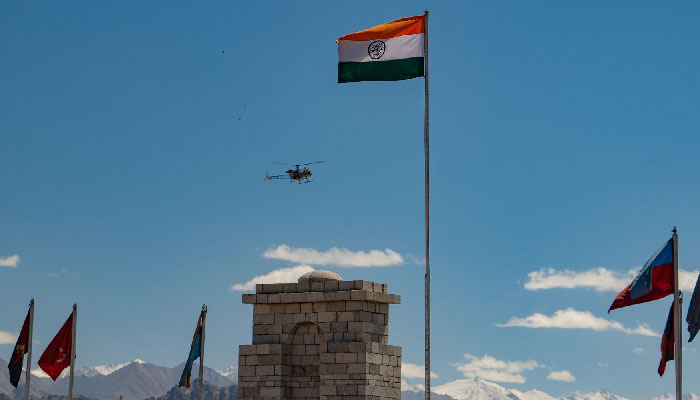Kashmir amidst Two-Front War
Louiss Althusser, in his exploration of state power, explains two apparatuses through which authoritarian states seek to acquire absolute submission: the repressive state apparatus and the ideological state apparatus. At present, it would seem that India, as a state, is currently operating this twin mechanism well with full rigour in the occupied territory of Kashmir. As if the armed oppression of the people of Kashmir did not suffice, the state is actively indulged in political oppression coupled with propagation of a narrative that paints the very people of Kashmir as villains in India’s manufactured tales of the Kashmiri land, trapping the people in two-front war in efforts to gradually erase their identities.
The repressive state apparatus is operating at full throttle, armed oppression in the form of brutal tortures and killing of Kashmiri people have become the state’s instrument of control within the Indian Illegally Occupied Jammu and Kashmir (IIOJK). Ideological state apparatus in the form of political oppression, on the other hand, aims at making the region ungovernable so that status of union territory can be retained in favour of the central government. The recent developments including the so called legislative Assembly elections that were held in IIOJK from 18 September to 1 October 2024, elected 90 members to the new illegally formed Jammu and Kashmir Legislative Assembly as to serve as puppet legislatures under a titular chief minister with its cabinet playing second fiddle to an unelected appointee, the lieutenant governor.
Although, Bharatiya Janata Party (BJP)’s effort to convert a demographic Muslims majority valley into a political minority failed this time as the votes in the valley were highly anti-BJP and their proxies like ‘Apni Party’ and ‘Awami Ittehad Party’. However, this marks the first instance that BJP has secured 29 seats in the Jammu region by emerging as a second largest party after Kashmir National Conference (JKNC), which secured 49 seats in coalition with the Indian National Congress (INC) and the Communist Party of India (Marxist) (CPI (M)). The whole situation is highly indicative of growing realisation of Hindutva aspirations to shift the balance of power in the region.
Take for example, the current political situation of IIOJK. Through measures such as the delimitation of the constituencies, the inclusion of non-resident voters via remapping electoral roles, and the New Domicile Law of 2019, which granted domiciles to non-Kashmiris, the BJP-led central government has created a perfect recipe for creating a politically charged and polarised environment in the region. If in case, the local parties wish to govern the region, the state has effectively ensured their eventual failure. This, in turn, seems to be an effort to retain the centre’s control over the region and alter the political distributions in such a way as to solidify pro-Hindutva parties in the region.
The ideological state apparatus that is currently employed by the Indian state also takes the form of digital and print mediums of knowledge and entertainment, which constitutes a significant aspect within the broader scheme of oppression. Althusser reveals that the experience of watching a film or reading a book has underlying mechanisms and psychological processes which are related to deep ideological implications. In a way, these mediums can be used to ‘reinvent’ history and reconstruct memories.
For the past couple of years, Indian state has accelerated its efforts to produce cinema that portrays Kashmiri Muslims in a villainous light. Such content skyrocketed specially after the abrogation of the Article 370, establishing false narrative, propagating Islamophobia, and building false icons of Hindutva. The media industry executes it in such a cunning way that it would put Goebbels to shame. Such fictional content mainly aims to justify Indian armed forces illegal presence in the occupied region by dehumanising the local people. In the recent years, it has been consistently observed that incidents of violence against Muslims across India surge right after such media productions.
This rhetoric extends beyond the fictional media to Indian news agencies that readily disseminate misinformation. Indian media promotes the narrative of Indians being welcome by Kashmiris and portrays the region as normal. It is a tactic that has been functional since occupation to re-enforce illegal India control over the region. Furthermore, international coverage has also been influenced by offering incentives to the foreign journalists in an effort to align India’s domestic and international narratives with the state interests as part of a wider strategy of gaining total ideological control over public discourse.
Under this scheme, the Indian government has attempted to supress the voices of Kashmiris in two ways: by physically eliminating them and by manufacturing false stories about them. However, the community has persevered by demonstrating indomitability. At the time, when Kashmiri people are trapped in a two-front war, it becomes even more important to express solidarity for Kashmiris, voice their concerns, and bear witness to their struggle and resilience.
Nida Khattak is a Researcher at the Centre for Aerospace and Security Studies (CASS), Lahore. She can be reached at info@casslhr.com.





Comments are closed, but trackbacks and pingbacks are open.